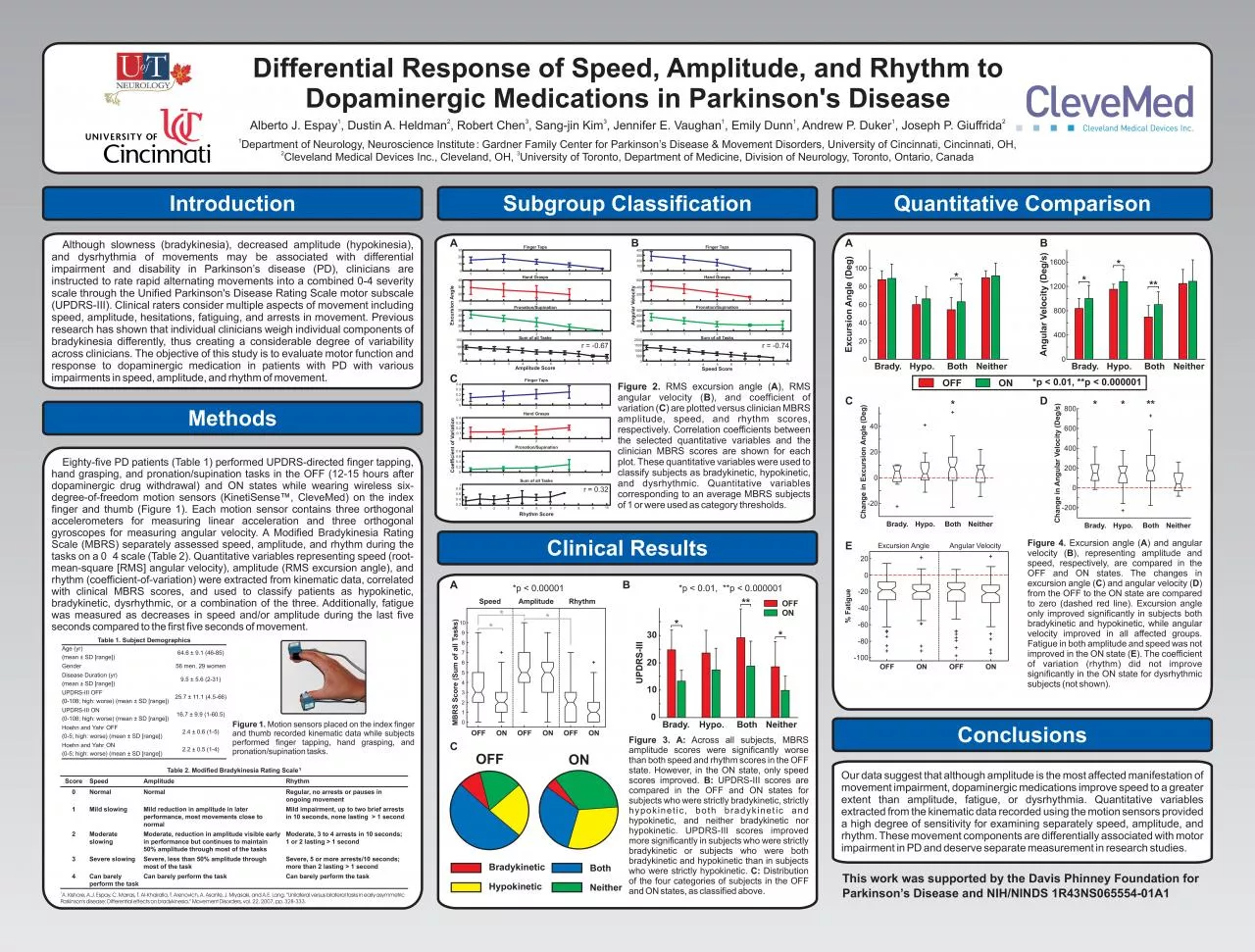

Introduction Subgroup Classification Quantitative Comparison Methods Conclusions Parkinsons Disease and NIHNINDS 1R43NS06555401A1 Clinical Results Althoughslownessbradykinesiadecreasedamplitude ID: 938164
Download Pdf The PPT/PDF document "Differential Response of SpeedAmplitude ..." is the property of its rightful owner. Permission is granted to download and print the materials on this web site for personal, non-commercial use only, and to display it on your personal computer provided you do not modify the materials and that you retain all copyright notices contained in the materials. By downloading content from our website, you accept the terms of this agreement.
Differential Response of Speed,Amplitude, and Rhythm toDopaminergic Medications in Parkinson's DiseaseAlberto J. Espay, DustinA. Heldman, Robert Chen, Sang-jin Kim, Jennifer E. Vaughan, Emily Dunn,Andrew P. Duker, Joseph P. Giuffrida233111Department of Neurology, Neuroscience Institute: Gardner Family Center for Parkinson"s Disease & Movement Disorders, University of Cincinnati, Cincinnati, OH,Cleveland Medical Devices Inc., Cleveland, OH,University ofToronto, Department of Medicine, Division of Neurology,Toronto, Ontario, Canada Introduction Subgroup Classification Quantitative Comparison Methods Conclusions Parkinson!s Disease and NIH/NINDS 1R43NS065554-01A1 Clinical Results Althoughslowness(bradykinesia),decreasedamplitude(hypokinesia),anddysrhythmiaofmovementsmaybeassociatedwithdifferentialimpairmentanddisabilityinParkinson"sdisease(PD),cliniciansareinstructedtoraterapidalternatingmovementsintoacombined0-4severityscalethroughtheUnifiedParkinson'sDiseaseRatingScalemotorsubscale(UPDRS-III).Clinicalratersconsidermultipleaspectsofmovementincludingspeed,amplitude,hesitations,fatiguing,andarrestsinmovement.Previousresearchhasshownthatindividualcliniciansweighindividualcomponentsofbradykinesiadifferently,thuscreatingaconsiderabledegreeofvariabilityacrossclinicians.TheobjectiveofthisstudyistoevaluatemotorfunctionandresponsetodopaminergicmedicationinpatientswithPDwithvariousimpairmentsinspeed,amplitude,andrhythmofmovement.Eighty-fivePDpatients(Table1)performedUPDRS-directedfingertapping,handgrasping,andpronation/supinationtasksintheOFF(12-15hoursafterdopaminergicdrugwithdrawal)andONstateswhilewearingwirelesssix-degree-of-freedommotionsensors(KinetiSense!,CleveMed)ontheindexfingerandthumb(Figure1).Eachmotionsensorcontainsthreeorthogonalaccelerometersformeasuringlinearaccelerationandthreeorthogonalgyroscopesformeasuringangularvelocity.AModifiedBradykinesiaRatingScale(MBRS)separatelyassessedspeed,amplitude,andrhythmduringthetasksona04scale(Table2).Quantitativevariablesrepresentingspeed(root-mean-square[RMS]angularvelocity),amplitude(RMSexcursionangle),andrhythm(coefficient-of-variation)wereextractedfromkinematicdata,correlatedwithclinicalMBRSscores,andusedtoclassifypatientsashypokinetic,bradykinetic,dysrhythmic,oracombinationofthethree.Additionally,fatiguewasmeasuredasdecreasesinspeedand/oramplitudeduringthelastfivesecondscomparedtothefirstfivesecondsofmovement.�1 or 2 lasting 1 secondin 10 seconds, none lasting�1 secondRegular, no arrests or pauses inTable 2. Modified Bradykinesia Rating Scale Table 1. Subject Demographics 2.2±0.5 (1-4)HoehnandYahrON(0-5; high: worse) (mean±SD [range])2.4±0.6 (1-5)HoehnandYahrOFF(0-5; high: worse) (mean±SD [range])16.7±9.9 (1-60.5)UPDRS-III ON(0-108; high: worse) (mean±SD [range])25.7±11.1 (4.5-66)64.6±9.1 (46-85)(mean±SD [range])9.5±5.6 (2-31)(mean±SD [range])UPDRS-III OFF(0-108; high: worse) (mean±SD [range])(0-A.Kishore,A.J.Espay,C.Marras,T.Al-Khairalla,T.Arenovich,A.Asante,J.Miyasaki,andA.E.Lang,UnilateralversusbilateraltasksinearlyasymmetricParkinson'sdisease:Differentialeffectsonbradykinesia,MovementDisorders,vol.22,2007,pp.328-333. Figure1.Motionsensorsplacedontheindexfingerandthumbrecordedkinematicdatawhilesubjectsperformedfingertapping,handgrasping,andpronation/supinationtasks. 01234012340123489 Finger TapsExcursionAngleSum of all Tasks 01234012340123489Finger TapsSum of all TasksOurdatasuggestthatalthoughamplitudeisthemostaffectedmanifestationofmovementimpairment,dopaminergicmedicationsimprovespeedtoagreaterextentthanamplitude,fatigue,ordysrhythmia.Quantitativevariablesextractedfromthekinematicdatarecordedusingthemotionsensorsprovidedahighdegreeofsensitivityforexaminingseparatelyspeed,amplitude,andrhythm.ThesemovementcomponentsaredifferentiallyassociatedwithmotorimpairmentinPDanddeserveseparatemeasurementinresearchstudies.Figure2.ARMSexcursionangle(),RMSangularvelocity(),andcoefficientofvariation()areplottedversusclinicianMBRSamplitude,speed,andrhythmscores,respectively.CorrelationcoefficientsbetweentheselectedquantitativevariablesandtheclinicianMBRSscoresareshownforeachplot.Thesequantitativevariableswereusedtoclassifysubjectsasbradykinetic,hypokinetic,anddysrhythmic.QuantitativevariablescorrespondingtoanaverageMBRSsubjectsof1orwereusedascategorythresholds. 01234Finger Taps01234Coefficient of Variation0123489Sum of all Tasks AB OFF MBRS Score (Sum of all Tasks) ONOFFONOFFON SpeedAmplitudeRhythm *** OFF ON Bradykinetic Both Brady.Hypo.BothNeitherExcursionAngle (Deg) Angular Velocity (Deg/s)Brady.Hypo.BothNeither Brady.Hypo.BothNeither OFFON **** OFF ON OFF ON -100 -80 -60 -40 -20 0 20 % Fatigue ExcursionAngleAngular Velocity ONOFF *p ABFigure3.A:Acrossallsubjects,MBRSamplitudescoresweresignificantlyworsethanbothspeedandrhythmscoresintheOFFstate.However,intheONstate,onlyspeedscoresimproved.UPDRS-IIIscoresarecomparedintheOFFandONstatesforsubjectswhoweres.UPDRS-IIIscoresimprovedmoresignificantlyinsubjectswhowerestrictlybradykineticorsubjectswhowerebothbradykineticandhypokineticthaninsubjectswhowerestrictlyhypokinetic.thefourcategoriesofsubjectstrictlybradykinetic,strictlyhypokinetic,bothbradykineticandhypokinetic,andneitherbradykineticnorhypokineticofintheOFFandONstates,asclassifiedabove.Figure4.ACDExcursionangle()andangularvelocity(),representingamplitudeandspeed,respectively,arecomparedintheOFFandONstates.Thechangesinexcursionangle()andangularvelocity()fromtheOFFtotheONstatearecomparedtozero(dashedredline).Excursionangleonlyimprovedsignificantlyinsubjectsbothbradykineticandhypokinetic,whileangularvelocityimprovedinallaffectedgroups.FatigueinbothamplitudeandspeedwasnotimprovedintheONstate().Thecoefficientofvariation(rhythm)didnotimprovesignificantlyintheONstatefordysrhythmicsubjects(notshown). Change in ExcursionAngle (Deg)Brady.Hypo.BothNeither Brady.Hypo.BothNeither**